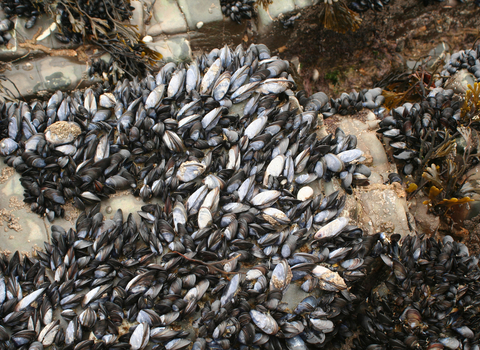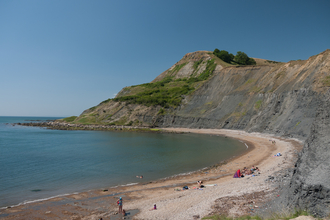
Mussels ©Julie Hatcher
Mussel
Scientific name
Mytilus edulisWhen to see
January to DecemberSpecies information
About
One of our most familiar bivalves (meaning two shells - or valves - that clamp together), the Common mussel lives on rocky, sandy or muddy shores, from the low tide mark and in shallow seas all around the UK. It forms large, dense mussel beds that cover the seabed, with each mussel attaching itself to the seabed and each other using sticky fibres called byssus threads. If uncovered at low tide, mussel beds become a seabird buffet - particularly for the noisy Oystercatcher. They are also an important food source for many creatures, including Starfish, Flatfish, Crabs and Dog whelks. They aren't helpless victims though and will use their sticky byssus threads to immobilise the Dog whelk predator, resulting in its slow death. Mussels are filter feeders, filtering detritus and plankton from the water. Their shells are usually a blueish-grey colour, though they are sometimes purple or brown. They are also known as the Blue Mussel.How to identify
A very familiar shell, almost triangular in shape and blue-ish grey in colour with concentric lines.Distribution
Found around all UK coasts.Did you know?
Common mussels have a beard! The tuft of byssal threads that anchor the mussel to the seabed and other mussels are often called the beard - and they are incredibly strong! Scientists have found that the threads have a soft, stretchy core surrounded by a tough outer coating - allowing them to withstand rough seas and big waves without being washed away.How people can help
Avoid products containing microplastics, check the label for Polyethylene and Polypropylene. Many sewage pollution problems occur because of misconnected household pipes - make sure your washing machine and toilets are plumbed into the foul water sewer, rather than the surface water sewer. Foul water is treated whilst surface water simply flows out to sea. Check out connectright.org.uk for more information. You can also help keep our sewers functioning properly and our beaches clean by only flushing the 3Ps down the loo: Pee, Paper, Poo. Everything else goes in the bin. The Wildlife Trusts are working with fishermen, researchers, politicians and local people towards a vision of 'Living Seas', where marine wildlife thrives. Do your bit for our Living Seas by supporting your local Wildlife Trust or checking out our Action pages.



